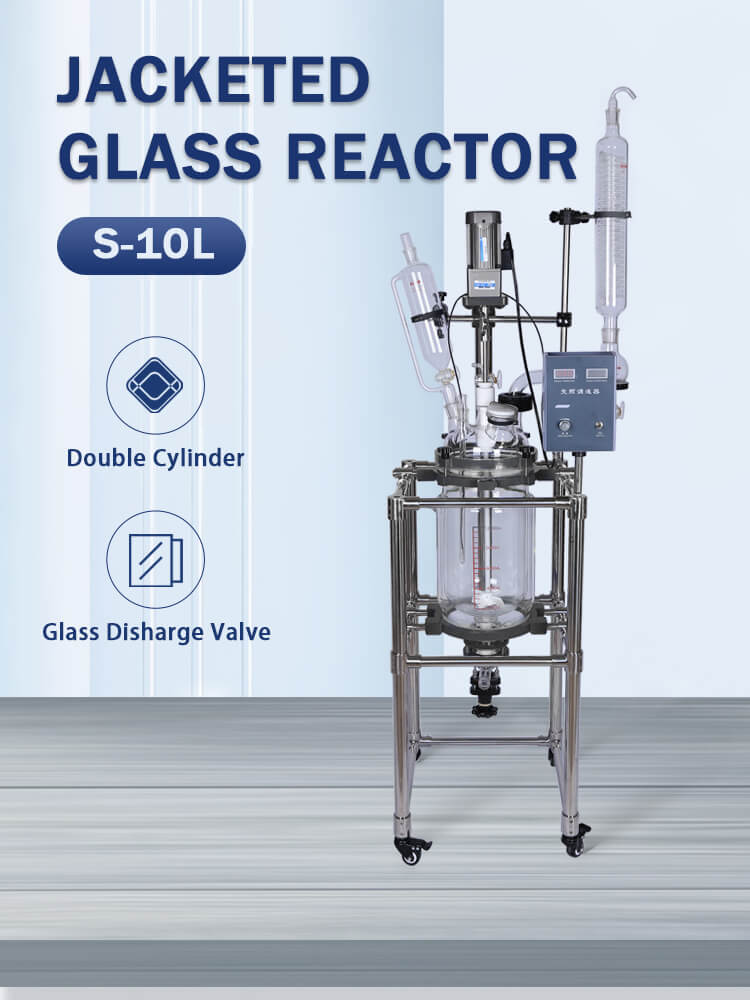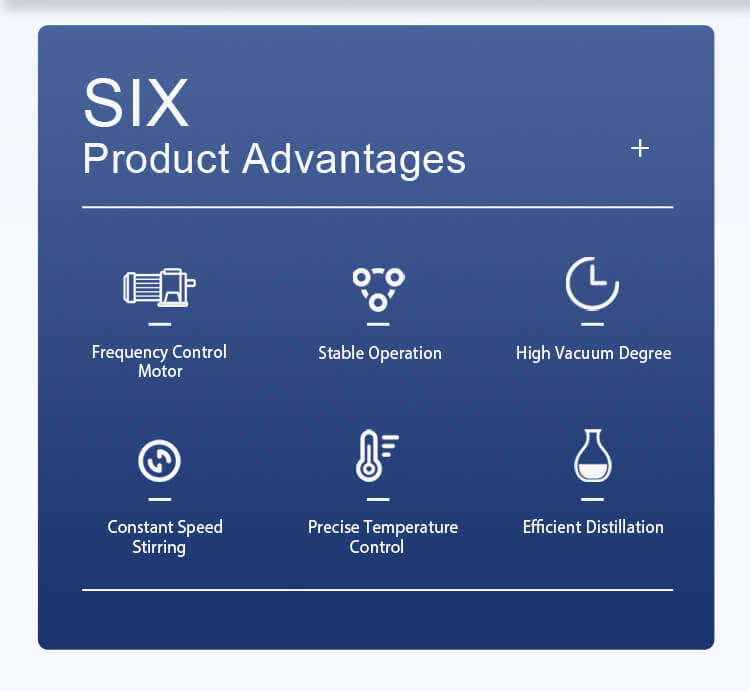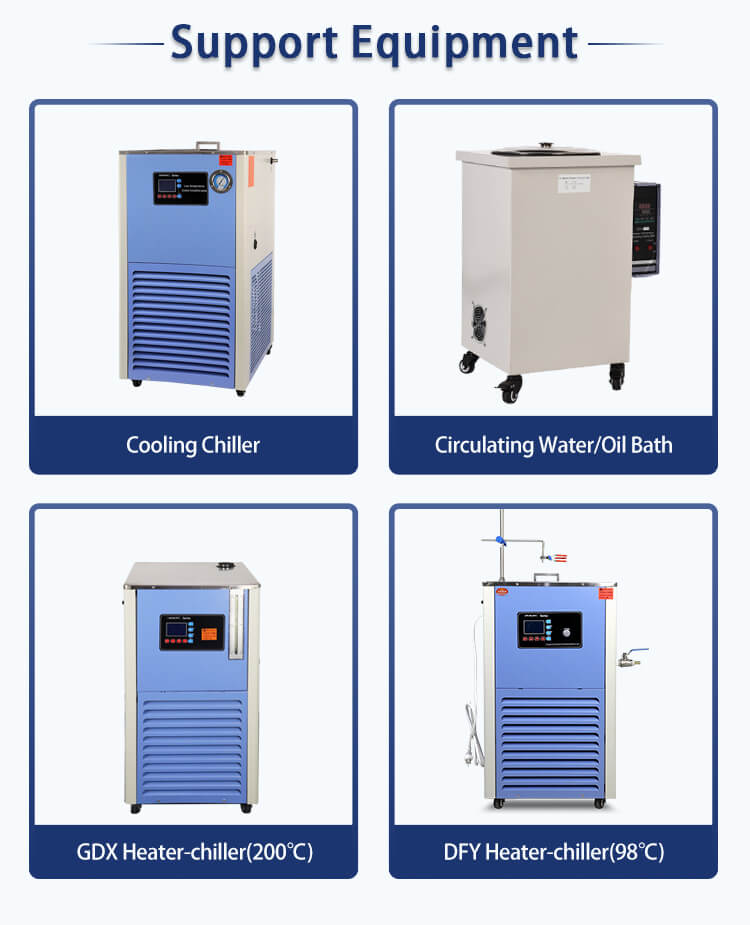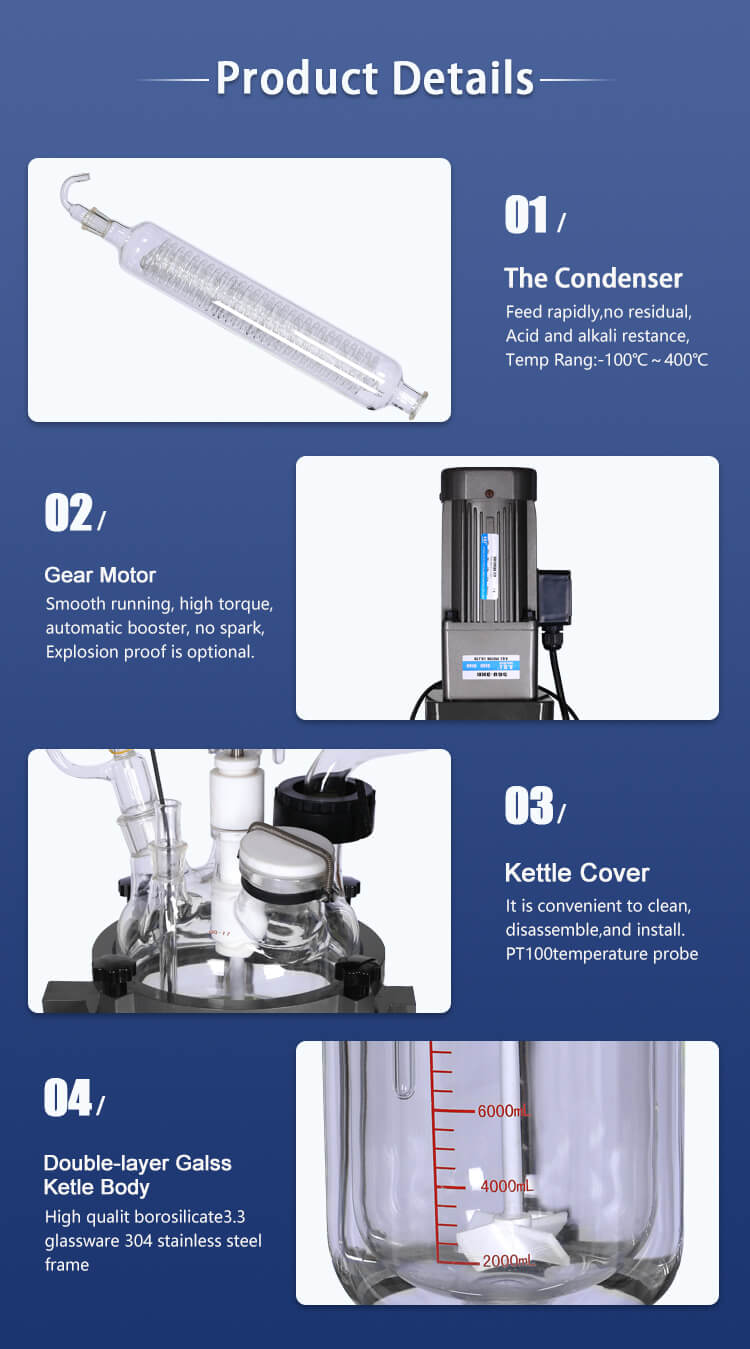- +86 17324835373
- [email protected]
- 19/F, Block B, Guohong Mansion, Zhengzhou, Henan, China
A glass filter reactor is a type of chemical reactor that utilizes a glass vessel to contain a reaction mixture, along with a filter at the bottom to separate the solid and liquid phases. The filter can be made of various materials such as glass frits or sintered metal, and is placed at the bottom of the reactor vessel. The reaction mixture is stirred using a magnetic stirrer, and the solid is filtered out using the filter at the bottom.

Glass filter reactors are commonly used in the pharmaceutical, chemical, and biotech industries for various applications such as catalyst screening, process optimization, and product development. The glass construction of the reactor allows for easy observation of the reaction, and the use of a filter allows for efficient separation of the solid and liquid phases.
1. Transparency: Glass filter reactors are transparent, allowing researchers to observe the reaction in real-time. This is especially important for reactions that involve color changes or the formation of precipitates.
2. Corrosion resistance: Glass is highly resistant to chemical attack, making it ideal for use in corrosive environments.
3. Easy to clean: Glass is non-porous and smooth, which makes it easy to clean and sterilize. This is important for maintaining the purity of the reaction mixture and avoiding cross-contamination.
4. Versatility: Glass filter reactors can handle a wide range of reaction conditions, including high temperatures and pressures. They can also be used for a variety of reactions, including mixing, heating, cooling, and filtering.
5. Safe: Glass filter reactors are non-reactive and non-toxic, making them safe for use in a laboratory environment.
6. Scalability: Glass filter reactors come in a variety of sizes, from small bench-top models to large-scale reactors. This allows researchers to scale up their reactions as needed.
Glass filter reactors are a versatile and reliable tool for chemical synthesis and process development. They are commonly used in the pharmaceutical, chemical, and biotech industries, as well as in academic research.

Glass filter reactors find a wide range of applications in the chemical, pharmaceutical, and biotech industries, as well as in academic research. Here are a few examples of applications of glass filter reactors:
1. Catalyst screening: Glass filter reactors can be used for catalyst screening in various chemical reactions, such as hydrogenation, oxidation, and polymerization. Researchers can easily observe the reaction progress and filter out the solid catalyst using the glass frit filter.
2. Process optimization: Glass filter reactors can be used to optimize reaction conditions, such as temperature, pressure, and stirring rate. Researchers can quickly adjust the reaction conditions and observe the effects on the reaction in real-time.
3. Product development: Glass filter reactors can be used to develop new chemical products, such as pharmaceuticals, fine chemicals, and specialty materials. Researchers can use the glass reactor to optimize the reaction conditions and monitor the progress of the reaction, as well as to filter and isolate the product.
4. Bioprocessing: Glass filter reactors can be used for various bioprocessing applications, such as fermentation, cell culture, and enzyme catalysis. The glass reactor vessel allows researchers to observe the growth of microorganisms or cells, and the filter at the bottom can be used to separate the biomass from the culture broth.
5. Material synthesis: Glass filter reactors can be used for the synthesis of various materials, such as nanoparticles, nanotubes, and thin films. The glass reactor vessel provides a controlled environment for the synthesis of these materials, and the filter at the bottom can be used to isolate the final product.
Glass filter reactors are a versatile tool for chemical synthesis and process development, offering transparency, corrosion resistance, and scalability for a wide range of applications.

The operation of a glass filter reactor generally involves the following steps:
1. Set up the reactor: Install the glass reactor vessel and the filter at the bottom of the reactor. Connect the reactor to a heating or cooling source, and attach the stir bar to the magnetic stirrer.
2. Prepare the reaction mixture: Add the appropriate amount of reagents and solvents to the glass reactor vessel. Mix the solution using the magnetic stirrer until the reagents are fully dissolved.
3. Start the reaction: Heat or cool the reaction mixture to the desired temperature and start the reaction by adding the catalyst or initiator, if necessary. Monitor the reaction progress using the glass reactor vessel.
4. Filter the solid: Once the reaction is complete, turn off the heat or cooling source and remove the stir bar. Allow the reaction mixture to settle, and then use the filter at the bottom of the reactor to separate the solid from the liquid phase.
5. Collect the product: Collect the solid product and wash it with the appropriate solvent to remove any impurities. Dry the solid product and weigh it to determine the yield.
6. Clean the reactor: Clean the glass reactor vessel and the filter thoroughly using the appropriate solvents and cleaning agents. Rinse with water and dry the reactor before the next use.
It is important to follow the specific operating instructions for the particular model of glass filter reactor being used, as there may be some differences in operation and setup. Additionally, it is important to follow all appropriate safety precautions, such as wearing appropriate personal protective equipment and following established laboratory protocols.

Q:What materials are glass filter reactors made of?
A:Glass filter reactors are typically made of borosilicate glass, which is highly resistant to thermal shock and chemical corrosion. The filter at the bottom of the reactor can be made of various materials such as glass frits or sintered metal.
Q:What is the maximum operating temperature and pressure for glass filter reactors?
A:The maximum operating temperature and pressure for glass filter reactors depend on the specific model and size of the reactor. Generally, glass filter reactors can operate at temperatures ranging from -80°C to 250°C and pressures ranging from vacuum to several atmospheres.
Q:What types of reactions can be performed in glass filter reactors?
A:Glass filter reactors can be used for a wide range of reactions, including mixing, heating, cooling, and filtering. They are commonly used for catalyst screening, process optimization, and product development in the chemical, pharmaceutical, and biotech industries.
Q:How do you clean a glass filter reactor?
A:To clean a glass filter reactor, first, remove any solid material from the reactor vessel and filter. Then, clean the vessel and filter with the appropriate solvent and cleaning agent, such as soap or detergent. Rinse the reactor with water and dry it before the next use.
Q:What safety precautions should be taken when using a glass filter reactor?
A:When using a glass filter reactor, it is important to wear appropriate personal protective equipment, such as safety glasses and gloves. It is also important to follow established laboratory protocols and safety procedures, such as using a fume hood for volatile or hazardous chemicals, and properly disposing of any waste materials.
Model | S-10L | S-20L | S-30L | S-50L | S-100L |
Stirring Power(W ) | 120 | 250 | |||
Stirring Speed(rpm) | 0~600(Max. 1300 | ||||
Stirring Shaft Diameter(mm) | 12 | 15 | |||
Reaction Kettle Capacity(L) | 10 | 20 | 30 | 50 | 100 |
Power Supply | 220V 50/60 Hz | ||||
Motor Torque(g/cm) | 1000 | 1200 | 1500 | 3000 | |
Note | 304 all stainless frame | ||||
Explosion-proof | 1. The stirring power (W): 180, 250, 370 2. Power supply: 220V / 50Hz or 110V / 60Hz | ||||
Please leave your contact information, we will arrange the business staff to contact you as soon as we see the message.
Copyright © 2022. ZZKD machinery equipment co., LTD All rights Sitemap